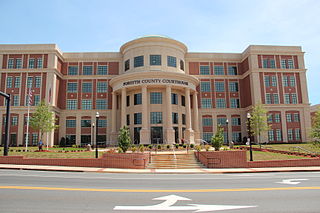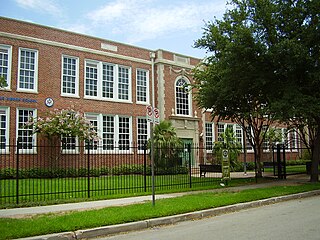Brown v. Board of Education of Topeka, 347 U.S. 483 (1954), was a landmark decision of the U.S. Supreme Court in which the Court ruled that U.S. state laws establishing racial segregation in public schools are unconstitutional, even if the segregated schools are otherwise equal in quality. The Court's decision partially overruled its 1896 decision Plessy v. Ferguson, declaring that the "separate but equal" notion was unconstitutional for American public schools and educational facilities. It paved the way for integration and was a major victory of the civil rights movement, and a model for many future impact litigation cases.

Forsyth County is a county in the north-central portion of the U.S. state of Georgia. Suburban and exurban in character, Forsyth County lies within the Atlanta Metropolitan Area. The county's only incorporated city and county seat is Cumming. As of 2019 estimates, the population was 244,252. Forsyth was the fastest-growing county in Georgia and the 15th fastest-growing county in the United States between 2010 and 2019.

Hopewell is a borough in Mercer County, New Jersey, United States. This historical settlement is located within the heart of the Raritan Valley region. As of the 2010 United States Census, the borough's population was 1,922, reflecting a decline of 113 (-5.6%) from the 2,035 counted in the 2000 Census, which had in turn increased by 67 (+3.4%) from the 1,968 counted in the 1990 Census.

Race-integration busing in the United States was the practice of assigning and transporting students to schools within or outside their local school districts in an effort to diversify the racial make-up of schools. While the 1954 U.S. Supreme Court landmark decision in Brown v. Board of Education declared racial segregation in public schools unconstitutional, many American schools continue to remain largely uni-racial due to housing inequality. In an effort to address the ongoing de facto segregation in schools, the 1971 Supreme Court decision, Swann v. Charlotte-Mecklenburg Board of Education, ruled that the federal courts could use busing as a further integration tool to achieve racial balance.
Lum v. Rice, 275 U.S. 78 (1927), is a United States Supreme Court case in which the Court held that the exclusion on account of race of a child of Chinese ancestry from a public school did not violate the Fourteenth Amendment to the United States Constitution. The decision effectively approved the exclusion of any minority children from schools reserved for whites.
Massive resistance was a strategy declared by U.S. Senator Harry F. Byrd Sr. of Virginia and his brother-in-law James M. Thomson, who represented Alexandria in the Virginia General Assembly, to get the state's white politicians to pass laws and policies to prevent public school desegregation, particularly after the Brown v. Board of Education Supreme Court decision in 1954. Many schools, and even an entire school system, were shut down in 1958 and 1959 in attempts to block integration, before both the Virginia Supreme Court and a special three-judge panel of Federal District judges from the Eastern District of Virginia, sitting at Norfolk, declared those policies unconstitutional.

The Dallas Independent School District is a school district based in Dallas, Texas (USA). It operates schools in much of Dallas County and is the second-largest school district in Texas and the seventeenth-largest in the United States. It is also known as Dallas Public Schools (DPS).
Austin Independent School District (AISD) is a school district based in the city of Austin, Texas, United States. Established in 1881, the district serves most of the City of Austin and surrounding towns, the City of Sunset Valley, the Village of San Leanna, and unincorporated areas in Travis County. The district operates 129 schools including 84 elementary schools, 19 middle schools, and 17 high schools. As of 2013 AISD covers 172.4 square miles (447 km2) of land within the City of Austin, making up 54.1% of the city's territory.

Phillis Wheatley High School is a secondary school located at 4801 Providence Street in Houston, Texas, United States with a ZIP code of 77020. Wheatley is a part of the Houston Independent School District. Wheatley, named after Phillis Wheatley, is located inside the 610 Loop in the Fifth Ward.
Arlington Public Schools is a public school division in Arlington County, Virginia. In 2019, student enrollment was 28,020 students, with students coming from more than 146 countries. In 2015, there were 2,166 teachers. There are 24 elementary schools, 6 middle schools, 4 high schools, 1 secondary institution and 4 other educational programs within the school district.

Beaumont Independent School District is a U.S. public school district serving Beaumont in Southeast Texas. The district originated in the annexation of the former Beaumont ISD by the South Park Independent School District after its trustees voted in 1983 to dissolve it as the culmination of a struggle over desegregation of both districts. The original Beaumont ISD had previously absorbed the smaller French ISD.

Magnolia Park is an area of the East End, Houston, Texas, located near the Houston Ship Channel. One of the oldest Hispanic neighborhoods in the City of Houston, Magnolia Park was formerly incorporated as the City of Magnolia Park in eastern Harris County.

Covington County Schools is a public school district based in Covington County, Mississippi, which serves the towns of Collins, Seminary, and Mount Olive, as well as rural regions throughout the county. The district’s boundaries parallel that of Covington County.

Sylvia Mendez is an American civil rights activist of Mexican-Puerto Rican heritage. At age eight, she played an instrumental role in the Mendez v. Westminster case, the landmark desegregation case of 1946. The case successfully ended de jure segregation in California and paved the way for integration and the American civil rights movement.
Desegregation of the Baltimore City Public Schools took place in 1956 after the United States Supreme Court ruled, in the case of Brown v. Board of Education, that segregation in schools went against constitutional law. Desegregation of U.S. schools was part of the civil rights movement. The events that followed desegregation in Baltimore, were important to the civil rights movement across America. Recent scholarship has identified Baltimore's desegregation as an important precursor to the Greensboro sit-ins.

Harvard Elementary School is a public primary school in the Houston Heights neighborhood of Houston, Texas, United States. Harvard, a part of the Houston Independent School District, serves grades Pre-Kindergarten through 5.

Dora B. Lantrip Elementary School is a primary school at 100 Telephone Road in the Eastwood community in the East End region of Houston, Texas, United States. The school is within the Houston Independent School District (HISD).
Daniel Holcombe Thomas was a United States District Judge who served nearly five decades on the United States District Court for the Southern District of Alabama.

Tuscaloosa City Schools is a public school district headquartered in Tuscaloosa, Alabama, United States. The district's boundaries are the city limits of Tuscaloosa.
The Greenville Eight was a group of African American students, seven in high school and one in college, that successfully protested the segregated library system in Greenville, South Carolina in 1960. Among the eight was Jesse Jackson, a college freshman. As a result of the staged sit-in, the library system in the city integrated.















